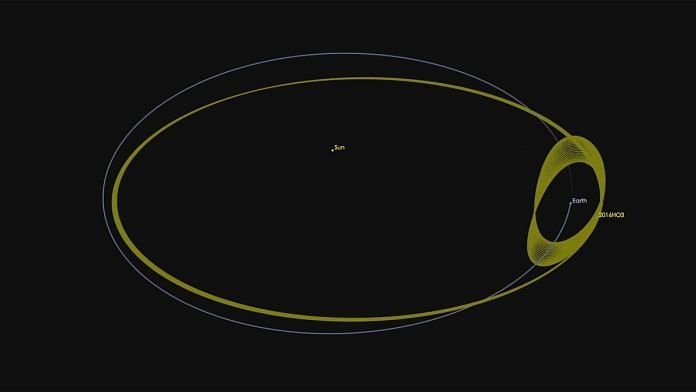Bengaluru: One of Earth’s quasi-satellites, discovered in 2016 and known as Kamoʻoalewa, is likely a piece of the Moon that once broke away from an impact, a new study in the US said.
A quasi-satellite is a near-earth asteroid that orbits the Sun with an orbital period similar to that of the Earth’s. From Earth’s perspective, the rock appears to orbit the Earth instead even though it doesn’t.
According to the study, the Kamoʻoalewa asteroid (also called 2016 HO3) is a fast rotator, spinning around fully every 28 minutes, and orbits the Sun every 366 days. It is at an orbit that is inclined to that of the Earth’s.
It is just about 41 meters across, and in its closest approach to Earth, comes to 13 times the distance of the Moon from us — roughly 50,00,000 km away. It is the smallest and most stable known quasi-satellite of Earth.
Astronomers were now able to study the reflection spectrum from Kamoʻoalewa using the Large Binocular Telescope and the Lowell Discovery Telescope, both in Arizona, and discovered that it is very similar to that of the Moon.
The findings indicated that the minerals that make up the asteroid are very similar in composition to that of the minerals found on the Moon’s surface. These spectral results, along with the asteroid’s orbital path, led the scientists to conclude that the piece of rock could be a fragment of the moon, released as debris from an impact event.
The authors also theorise that, alternatively, the rock came from the gravitational, non-contact breakup of a larger body that had a close encounter with the Earth-Moon system and was ripped apart by the Earth’s gravity.
They also state that it could potentially have originated from one of Earth’s as-yet undiscovered trojans or asteroids that orbit in the same orbit as Earth, leading or trailing Earth in a stable point in orbit.
The findings were published this week in the journal Communications Earth & Environment.
Earth’s quasi-satellites
Earth has over 20 quasi-satellites that are in permanent or temporary orbits. Even though these pieces of rock are physically close to our planet, they are very hard to observe due to their small and faint size — fainter than even the faintest star that can be seen with the naked eye in the night sky.
Kamo’oalewa has been observed only for a few weeks in April each year since its discovery five years ago.
The authors think that the asteroid began orbiting in this orbit around 500 years ago, and it is expected to remain so for another 300 years.
Also read: Imagine 34 Mount Everests stacked together — that’s the depth of Jupiter’s Great Red Spot



